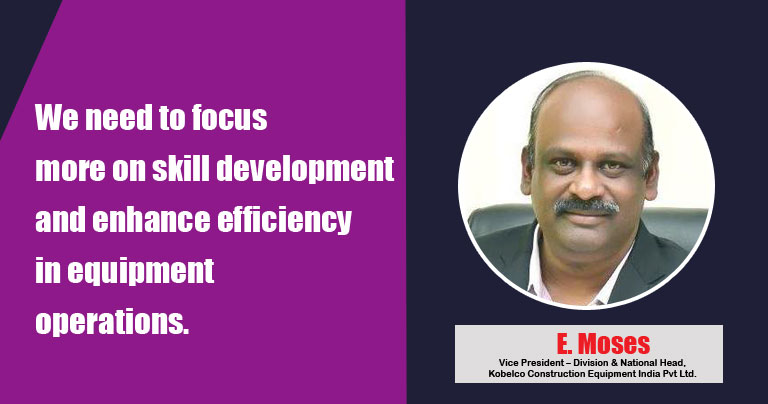How did you successfully manage your business in the Covid times? What were the key drivers for your growth?
Covid has brought tough challenges globally, whether at the macro or micro level. Like most business entities, we were also impacted quite severely to start with. The total lockdown had grounded practically everyone.
However, once the lockdown was relaxed, even though partially, we focused on quick resumption of all services by activating all our dealerships. We had utilised the lockdown period to identify the immediate constraints and developed strategies to address them. We had to extend a helping hand to ‘kick-start’ the business as liquidity was a prime issue. We had been in touch with customers and kept them engaged with brush-up trainings. Few sectors like Mining were only marginally affected and we were able to support them through improvised logistics. It was clear that early revival was viable only through working together.
On the sales and marketing front, the digital platform proved to be the savior considering the serious limitations of physical movement and inter-actions. All the stakeholders adopted the digital option and made it possible for business to not only resume but move ahead rapidly as well.
How do you evaluate the recovery in the construction equipment market so far?
With the exception of the first quarter of 2020-21, which was practically a washout, there was a gathering momentum and this was pretty obvious. With government support in reviving the ongoing projects, and the relaxation in the lockdowns, there was a positive trend which raised the prospects of closing 2020-21 on a fair note.
There was a wobble again in the first quarter of this year due to the second wave of Covid which caught many of us by surprise by its intensity. The numbers have been improving for almost everyone and the industry experts are predicting a healthy growth for the next couple of years.
What are the significant factors impacting the productivity in your sector?
Infrastructure building has been the dominant activity thanks to the government’s sustained thrust and funding. Of the various segments of the infrastructure sector, road construction, whether it is highways, expressways, PMGSY, or the dedicated freight corridors, has been a key driver in most areas. In recent years, mining and quarrying have shown positive trends in raising growth prospects.
What kind of policy/regulations/investments support is required for the market revival?
The authorities could do well to ensure adequate liquidity, timely land clearances, quick and fair resolution of contract-related disputes, maintain the work-pace over the medium term at-least, etc. Equipment financing needs a boost through some incentivisation, if possible, to encourage mechanisation to support faster execution of works. Some tax relief could also be a desirable support to the industry.
One more area which requires government support is skill development, though a lot has been done. However, there are gaps which nullify any gains. For example, it is still not mandatory that all Operators be certified. Consequently, new entrants are discouraged as existing Operators continue to hold the jobs even without certification. So, why should someone spend money to get trained and certified? Also, training aids including equipment as well as simulators are not available for proper training. Cost constraints and the multiple types of equipment are key challenges.
Can technology and digitisation be a key factor in driving your sector’s growth?
The use of latest technology has been an ongoing practice. The adoption of technology by the end-user is another aspect as it entails an increase in owning costs, though operating costs might show a dip. Most companies are caught in a dilemma of whether to bring in new technologies or not. In a market which is predominantly price-sensitive, on one side there is a clear value-addition, but any increase in cost could affect sales negatively.
In order to promote new technologies, companies must be able to reliably communicate the commercial advantages gained by the user to make them realise that it is not just an additional cost for them; rather it is like a ‘win-win’ situation for all. Sometimes, government regulations force companies to bring in the new technologies compulsorily like the emission norms which are being implemented for construction equipment.
Digitisation is getting adopted relatively faster as it is making its way across so many platforms and touches our lives in so many ways. Setting up of 5G networks will further support the pace of digitisation in the coming years.
How do you assess the growth prospects for the next 5 years in the mining and construction equipment market?
This is a rather tricky exercise. If one looks back over the past couple of decades, we see a pattern which is not so inspiring. We have had two to three years of growth spells followed by a dip lasting around two years and this gets repeated again and again. The dips are brought about by various factors like the impact of international/ domestic events, elections or other political vibes, etc.
Considering this, it is tough to predict a five-year trend. The current year as well as the next two years could be quite positive years. However, with the next general elections due in 2024, we could anticipate some disruption in overall economy, as on previous occasions. A lot will depend on the outcome of the elections as well.
Cookie Consent
We use cookies to personalize your experience. By continuing to visit this website you agree to our Terms & Conditions, Privacy Policy and Cookie Policy.


















